
Welcome to Your Secret Garden Haven
There’s something magical about stepping into a small secret garden – that feeling of discovering a hidden world of greenery and tranquility. I’ve spent years cultivating these intimate spaces for clients and in my own backyard, and I’ve learned that the right plants make all the difference. Whether you’re working with a tiny corner or a modest side yard, the perfect combination of flora can transform any space into an enchanting retreat.
Creating a small secret garden isn’t just about cramming plants into a space; it’s about selecting varieties that work together to establish privacy, intrigue, and that special sense of seclusion. In my experience, these seven plants consistently deliver that secret garden feel, even in the most compact spaces.
1. Lavender: A Fragrant Guardian

Lavender has always been my first recommendation for small secret garden ideas. This aromatic perennial creates an instant sensory experience that signals you’ve entered a special place. The moment visitors brush against lavender’s silvery foliage, they’re enveloped in its calming scent – nature’s way of announcing arrival to your hidden sanctuary.
I’ve found lavender particularly effective when planted along garden entrances or pathways. The fragrance creates an olfactory threshold that marks the transition into your secret space. Beyond its scent, lavender’s purple blooms add a soft, dreamy texture against harder garden elements like stone walls or wooden gates.
- English Lavender (Lavandula angustifolia) – Hardy, compact, and intensely fragrant; perfect for edging
- French Lavender (Lavandula stoechas) – Distinctive tufted blooms with butterfly-like bracts; more dramatic appearance
- Spanish Lavender (Lavandula stoechas) – Heat-tolerant with unique pine cone-shaped flowers
Pro Tip: Plant lavender in well-draining soil with full sun exposure. I once made the mistake of planting lavender in a shady, damp corner, and it quickly deteriorated. These Mediterranean natives thrive in conditions that mimic their homeland – sunny and relatively dry.
2. Ferns: Whispering Greenery
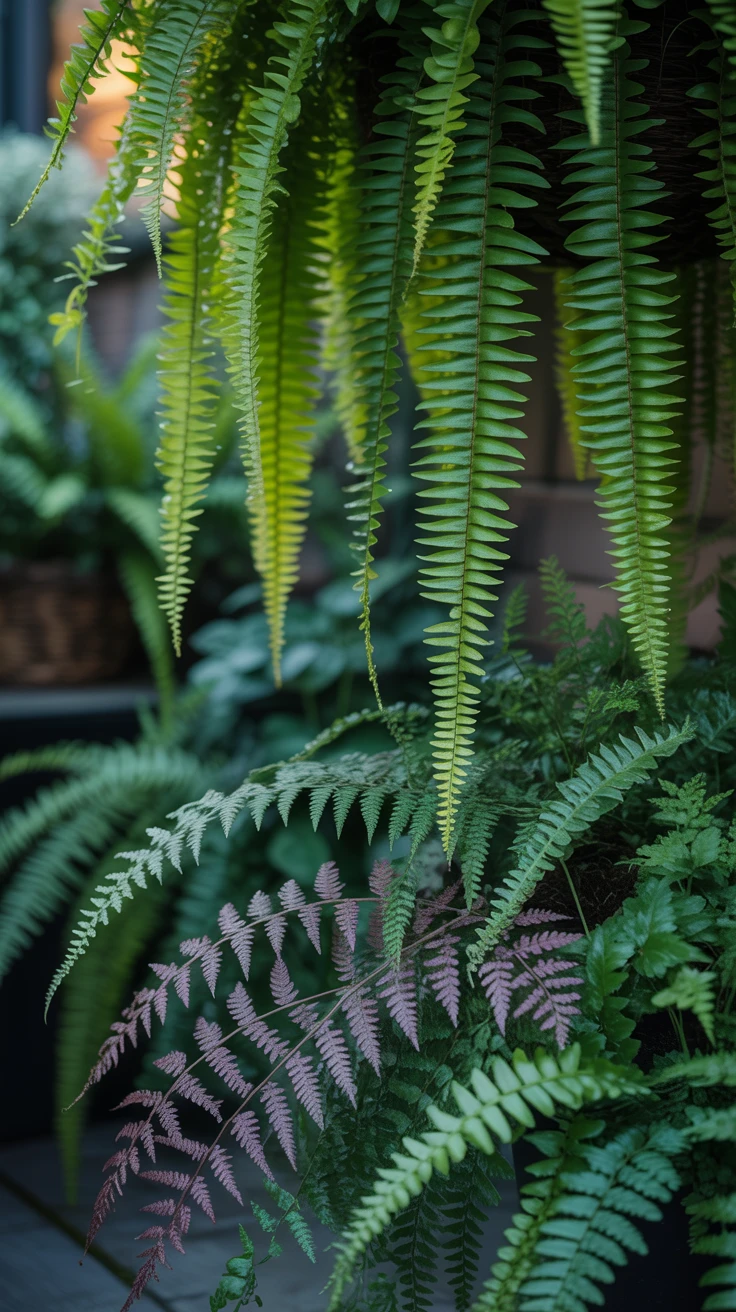
Every truly magical small secret garden needs ferns. These ancient plants bring an immediate sense of mystery and woodland charm to shaded corners. Their unfurling fronds create movement even on still days, seeming to beckon visitors deeper into your garden’s secrets.
I’ve used ferns extensively in my smaller garden designs, particularly in north-facing areas or spots beneath trees where other plants struggle. Their lacy textures contrast beautifully with broader-leaved plants and create that layered, discovered-not-designed feeling that secret gardens require.
- Maidenhair Fern (Adiantum) – Delicate, dancing fronds with black stems; brings elegance to any shady nook
- Japanese Painted Fern (Athyrium niponicum) – Silvery-purple fronds that seem to glow in dim light
- Boston Fern (Nephrolepis exaltata) – Lush, arching fronds perfect for hanging baskets or elevated planters
- Hart’s Tongue Fern (Asplenium scolopendrium) – Unusual strap-like fronds for textural contrast
Pro Tip: Create a fern grotto by clustering different varieties together in varying heights. I’ve found that misting ferns regularly during dry periods keeps them looking their best and enhances that secret, misty atmosphere that makes hidden gardens so appealing.
3. Hydrangeas: Blushing Boundaries
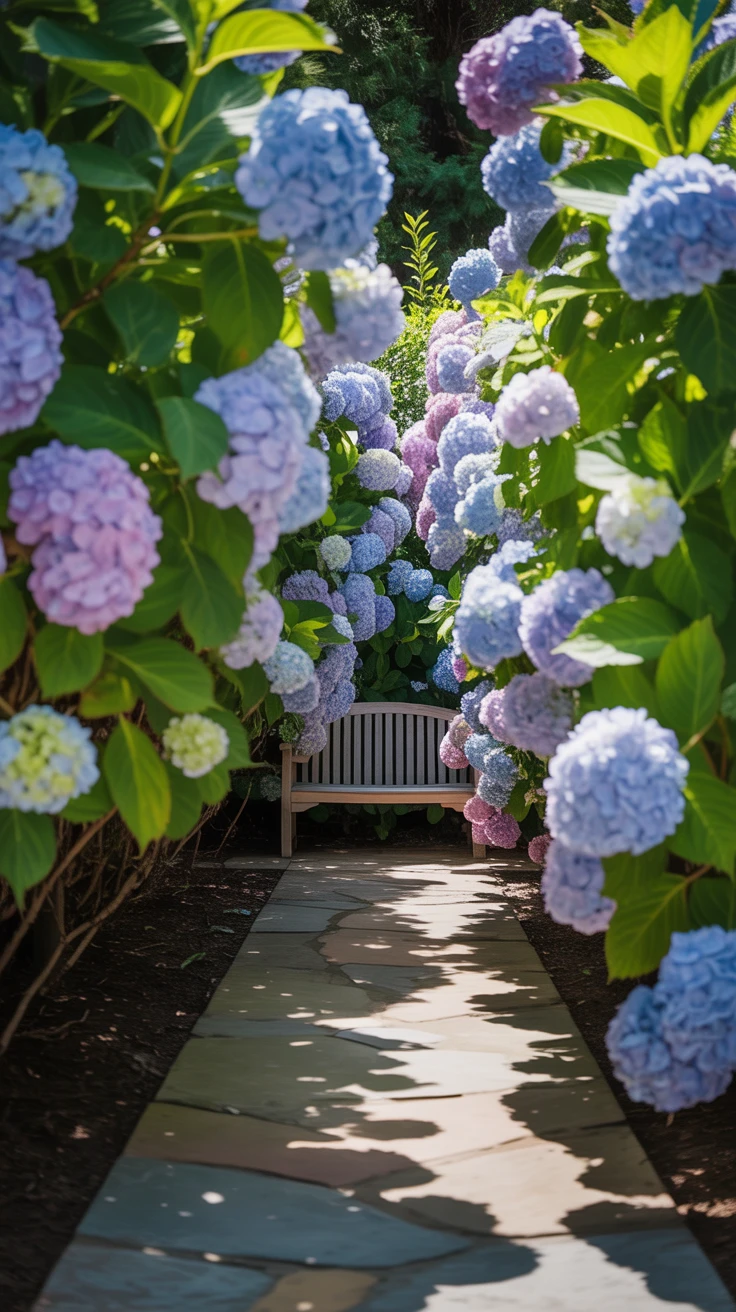
Hydrangeas have earned their place in my top plants for small secret garden ideas because they deliver both volume and beauty without demanding excessive space. These flowering shrubs create natural, blooming walls that conceal the outside world while drawing the eye with their spectacular flower heads.
I once transformed a client’s narrow side yard into a secret passage by lining it with hydrangeas. The effect was remarkable – the once-overlooked space became a mysterious corridor leading to a hidden seating area, with the hydrangeas’ massive blooms creating a sense of abundance in a limited area.
- Annabelle Hydrangea (H. arborescens) – Enormous white flower heads that brighten shady spots
- Bigleaf Hydrangea (H. macrophylla) – Color-changing blooms that respond to soil pH; blues and purples work best for secret gardens
- Oakleaf Hydrangea (H. quercifolia) – Dramatic foliage and cone-shaped blooms; excellent fall color
- Climbing Hydrangea (H. anomala petiolaris) – Perfect for covering walls or fences to enhance seclusion
Pro Tip: For truly compact spaces, look for dwarf hydrangea varieties like ‘Little Lime’ or ‘Bobo’ that stay under 3 feet tall but still produce impressive blooms. I’ve found these smaller varieties just as effective at creating that secret garden feeling without overwhelming tiny spaces.
4. Clematis: The Romantic Climber
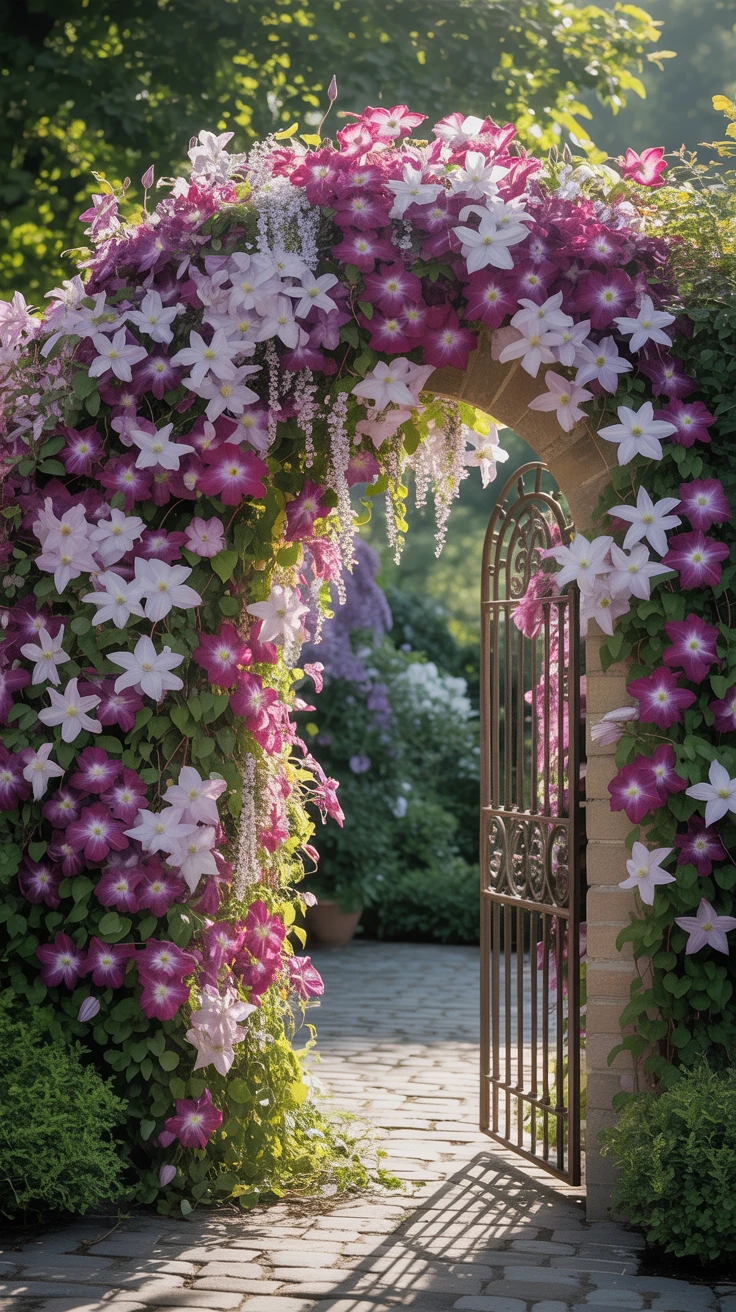
No plant embodies the romantic essence of a secret garden quite like clematis. These versatile climbers transform ordinary structures into extraordinary features, clothing arbors, trellises, and fences with cascades of blooms that seem straight from a fairy tale.
In my own garden, I’ve used clematis to create a flowering doorway that feels like a portal to another world. Visitors literally step through flowers to enter the space – an experience that never fails to delight and surprise.
- Nelly Moser – Large pink and white striped flowers; blooms on old and new wood
- Jackmanii – Abundant purple-blue flowers; vigorous and reliable
- Montana – Fast-growing with masses of small, fragrant blooms; excellent for covering large areas quickly
- Princess Diana – Tulip-shaped pink flowers with distinctive flared tips; more restrained growth habit
Pro Tip: Remember the gardener’s adage for clematis: “head in the sun, feet in the shade.” Plant clematis where the vine can climb into sunlight but keep the roots cool with surrounding plants or mulch. I learned this lesson the hard way after losing several clematis plants before understanding their unique growing requirements.
5. Hostas: Leafy Serenity
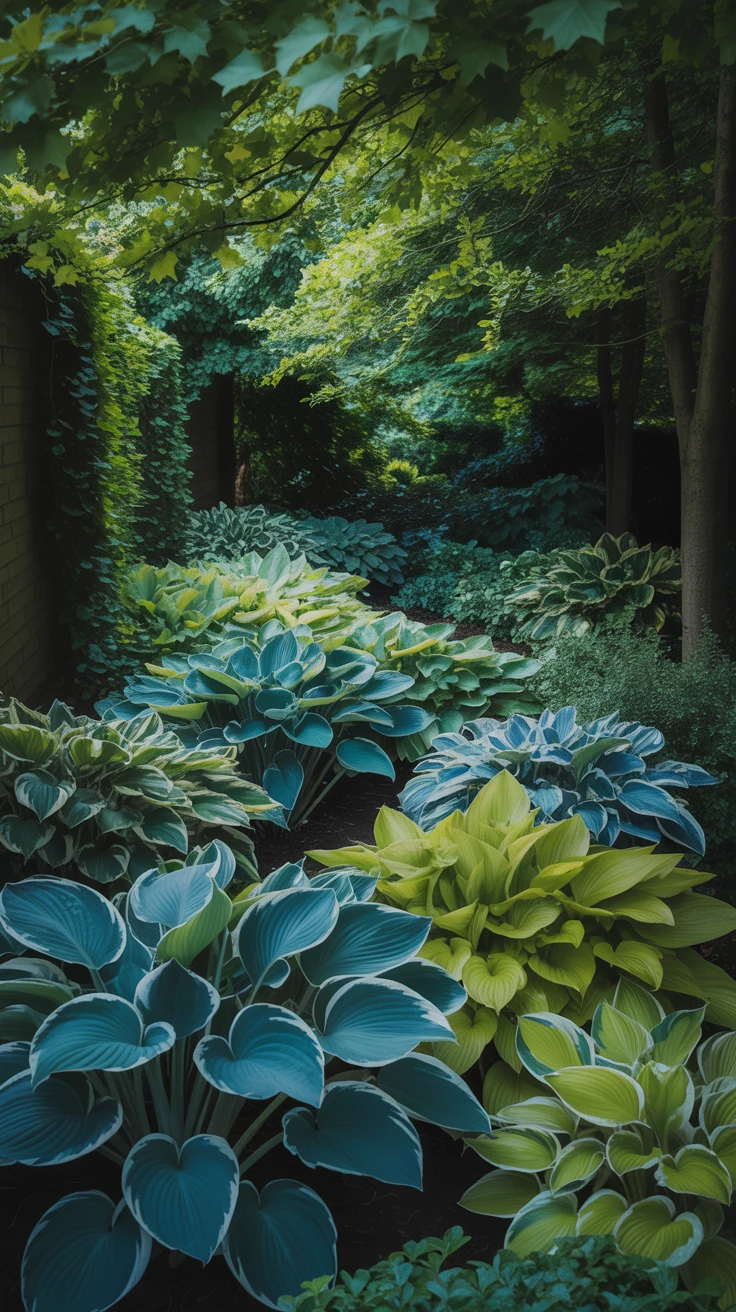
Hostas have been my reliable allies in creating serene, textural foundations for secret gardens. These shade-loving perennials bring a sense of lush abundance to dim corners with their magnificent foliage, varying from tiny cups to massive elephant-ear proportions.
What makes hostas particularly valuable in small secret gardens is their ability to thrive in those challenging spots where sun-loving plants struggle. I’ve used them to line hidden pathways, where their broad leaves seem to whisper against visitors’ legs as they pass – another sensory element that enhances the secret garden experience.
- Blue Mouse Ears – Miniature blue-green leaves; perfect for edging or container gardens
- Frances Williams – Large blue-green leaves with yellow margins; makes a statement in shady spots
- White Feather – Emerges pure white before developing green streaks; creates a ghostly effect
- Sum and Substance – Enormous chartreuse leaves; fills space quickly and dramatically
Pro Tip: Mix hostas with different leaf colors, sizes, and textures for a tapestry effect that looks designed by nature rather than human hands. In my garden, I’ve paired blue hostas with Japanese painted ferns and found the silver-blue combination creates an ethereal, moonlit quality even during daylight hours.
6. Japanese Maple: An Exotic Touch
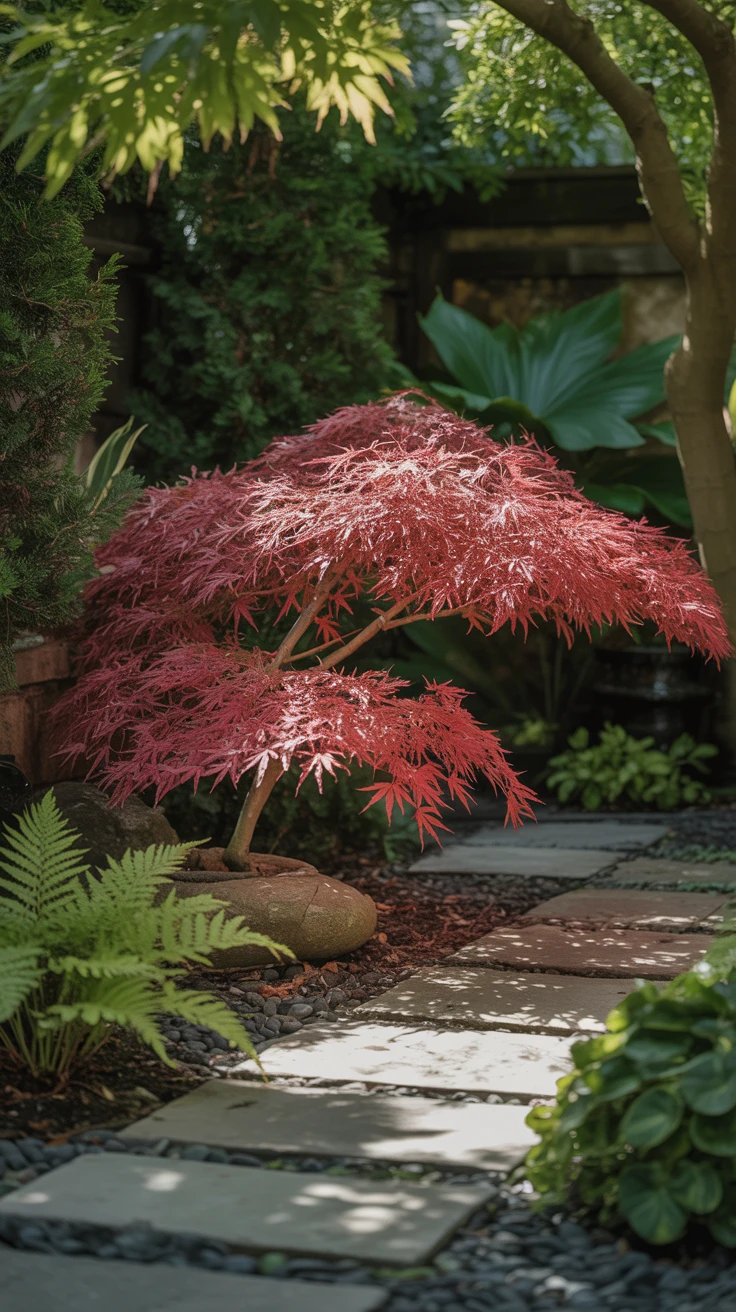
Even the smallest secret garden deserves one spectacular focal point, and Japanese maples deliver this with minimal space requirements. These architectural trees bring an immediate sense of age and establishment to young gardens, their distinctive leaf shapes and seasonal color changes creating year-round interest.
I’ve incorporated dwarf Japanese maples into tiny courtyard gardens with remarkable results. Their presence seems to compress time, making new gardens feel like discovered treasures rather than recent creations. The dappled shade they cast also creates ideal growing conditions for woodland plants beneath, extending your planting palette.
- Acer palmatum ‘Shaina’ – Compact form with dense, bright red foliage; stays under 6 feet
- Acer palmatum ‘Mikawa yatsubusa’ – Layered growth habit with leaves that overlap like shingles; exceptional structure
- Acer palmatum ‘Waterfall’ – Cascading branches with finely dissected green leaves that turn golden in fall
- Acer palmatum ‘Orangeola’ – Weeping form with leaves that transition from orange-red to bronze-green
Pro Tip: Position your Japanese maple where it can be viewed from your primary seating area. I’ve found that watching the light play through these trees’ leaves throughout the day creates a meditative experience that enhances the restorative quality of a secret garden.
7. Boxwood: The Protective Hedge
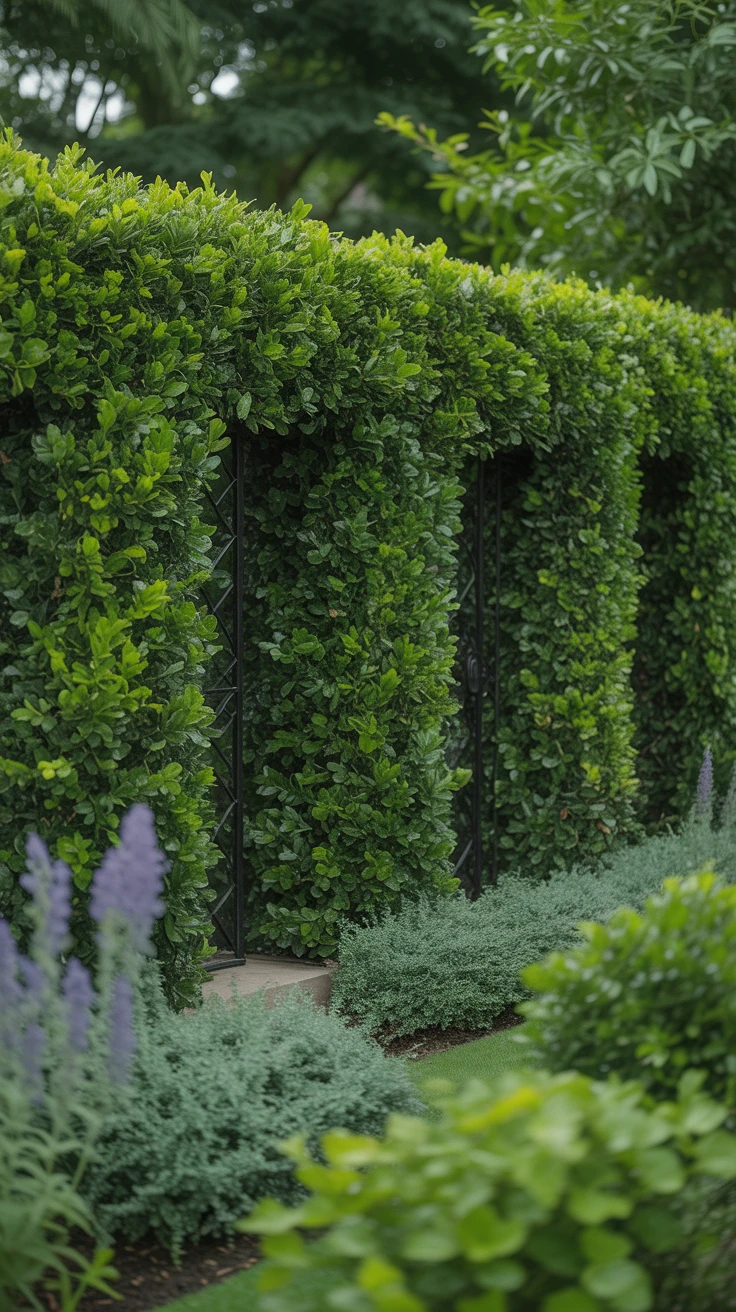
Every secret needs protection, and boxwood provides the perfect living walls for your hidden garden sanctuary. These evergreen shrubs have defined garden rooms for centuries, and their dense growth habit creates effective screens even when space is limited.
In my experience designing small secret gardens, boxwood’s greatest strength is its adaptability. It can be kept tightly clipped for formal designs or allowed to grow more naturally for a softer effect. I’ve used boxwood to create “doorways” in otherwise solid hedges, revealing hidden garden sections only to those who know where to look.
Beyond their screening capabilities, boxwoods bring a sense of permanence and structure that balances the more ephemeral flowering plants in a secret garden. Their year-round presence ensures your garden maintains its secluded feeling even in winter months.
Pro Tip: Consider using dwarf boxwood varieties like ‘Suffruticosa’ or ‘Morris Dwarf’ for small spaces. I once made the mistake of planting standard boxwoods in a tiny garden, only to spend years aggressively pruning them. The dwarf varieties give you the same effect without the constant maintenance.
Crafting Your Secret Hideaway
Creating a small secret garden is one of the most rewarding projects for any gardener. By combining these seven plants – lavender’s scent, ferns’ delicacy, hydrangeas’ abundance, clematis’ romance, hostas’ serenity, Japanese maples’ elegance, and boxwood’s structure – you can transform even the most modest space into an enchanting retreat.
Remember that the true essence of a secret garden lies not in its size but in the feeling it evokes. Layer your plants thoughtfully, engage all the senses, and create moments of discovery. Your garden may be small in square footage, but with these plants as your allies, it can be limitless in the joy and wonder it brings.
I encourage you to start small, perhaps with just three of these plants combined in a corner of your existing garden. Watch how they interact, how they make you feel when you’re among them, and then gradually expand your secret domain. Before long, you’ll have created a world entirely your own – a living secret that changes and grows with each passing season.

